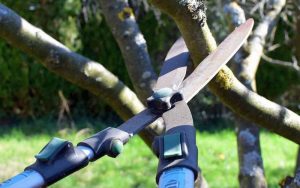Pruning and care of deciduous fruit trees
Robin Gale-Baker, from Sustainable Macleod, discusses the pruning and care of fruit trees. This is one of a series of articles she has written about growing fruit trees (see right hand sidebar). She has also written a number of articles about growing various vegetables, growing various herbs and general growing techniques.
Also, read Therese Scales’ article on pruning of deciduous fruit trees.
 Top tips
Top tips
- Prune individual fruit trees at the right time of year.
- Prune on a warm, dry day (especially for apricots and cherries).
- Remove suckers.
- Avoid using wound heal sprays.
- Avoid Bordeaux mix and use lime sulphur instead.
When to prune what
Over the years, advice on when to prune stone fruits has changed while advice on pome fruits (apples, pears and quinces) has remained the same. Here’s the current advice.
- Apples, pears and quince – in winter, when leafless. Prune on a dry day.
- Apricots – in late summer, after harvest.
- Cherries – in late summer, after harvest.
- Peaches and nectarines – new growth lightly in summer and complete the prune in autumn.
- Plums – in late summer or autumn, after harvest.
All stone fruit trees benefit by being pruned on a warm, dry day preferably with a breeze as this allows the cuts to dry out quickly and prevents bacterial infection and canker.
Suckers
Suckers grow out of the ground around the tree base or out from the lower trunk below the graft. There are two schools of thought on sucker removal. The first is to remove suckers when they appear (or anytime you notice them) as they weaken the tree. The second is to remove them in summer when the soil is dry, to prevent fungal infection taking hold on the pruning cuts.
Suckers are generally caused by damage to the roots so, prune off any damaged roots before planting. Be careful weeding or cultivating around the base of the tree as you may inadvertently damage roots close to the surface. Cut suckers out with sharp secateurs at ground level. It can be, and usually is, a recurring job!
Avoid using wound spray
Avoid spraying with a wound heal product because, in my experience, this does more harm than good. Trees need to form wood callouses on pruning wounds. Spraying or painting a wound prevents oxygen getting to it and results in poor callous development, which allows disease to enter the tree.
Spray fruit trees when leafless with lime sulphur
Lime sulphur is both an anti-fungal and a pesticide.
It protects pome fruit from black spot, several mites, San Jose scale and powdery mildew. Spray when the tree is leafless. Note that it is not suitable for Delicious or Cox’s Orange Pippin apples.
Lime sulphur is also effective on stone fruit and almonds for leaf curl, freckle, rust, shot hole, brown rot, bryobia mite and San Jose scale. Apply in winter while the trees are leafless prior to bud swell. Be sure to cover the tree 360 degrees around, making sure all the limbs and crotches are wet as this is a contact spray. In fact, clean out any crotches of dead leaves and insects before spraying. (A crotch is the V shape where the trunk meets the branches and it is a perfect place for litter to accumulate).
Note that spraying with lime sulphur won’t always prevent total infection of leaf curl (Taphrina deformans) as the spores are carried by wind and rain and you may get a small outbreak in spring. While unsightly, leaf curl should not affect fruiting too much except in young trees. If you are worried about it, pick off the affected leaves and bin them, making sure to remove any from the ground as these will reinfect the tree. In fact, re-infection may have come from litter beneath the tree in the first place as Taphrina deformans survives over winter on tree limbs and fallen leaves. Wet weather during spring escalates the development of curly leaf especially if the rain is mild.
The rate of application for both stone fruit and pomes is around 50ml per litre of water.
Keep swilling the spray container to keep it well mixed, and so it won’t clog the nozzle.
Avoid using Bordeaux mix
Bordeaux mix (copper sulphate) has been used since 1882. Invented in France and sprayed on grapes, it prevented fungal diseases in French vineyards and was a great boost to agriculture for over 100 years. However it is now banned in 17 EU countries and the UK because of its environmental impact. First, Bordeaux mix contains a heavy metal – copper – and overtime builds up in the soil as a heavy pollutant. Second, it is toxic to earthworms, fish (if it enters waterways), beneficial insects (including bees and ladybirds) and livestock. It also degrades fertility and soil microbiology. In Australia it can still be used as it is categorised as ‘organic’. If you want to use the last of your Bordeaux then wear protective clothes, glasses and gloves as it is toxic to humans. Cover the soil beneath your trees with newspaper or cardboard to protect it from drips and bin the covering after spraying. Apply to bare limbs only. Bordeaux is an anti fungal but not a pesticide which is another reason to spray with lime sulphur.

Hi
I found your articles very informative.
Kind regards
Gordon Frost
Excellent article Robin for a beginner like myself.
When is the best time to prune evergreen fruit trees like lemons and oranges?
Prune a citrus tree after it has finished fruiting, which is usually early Spring.